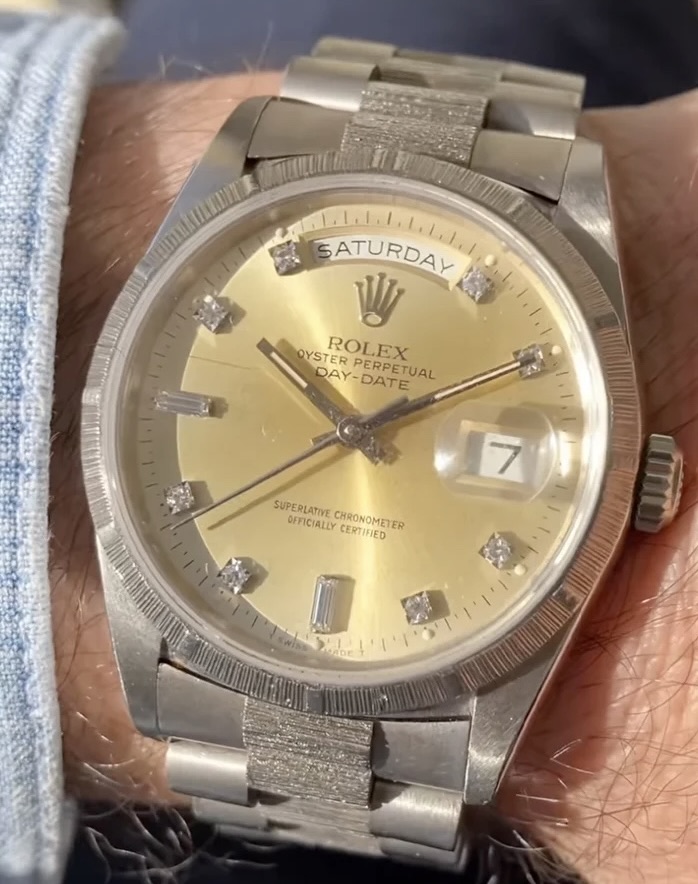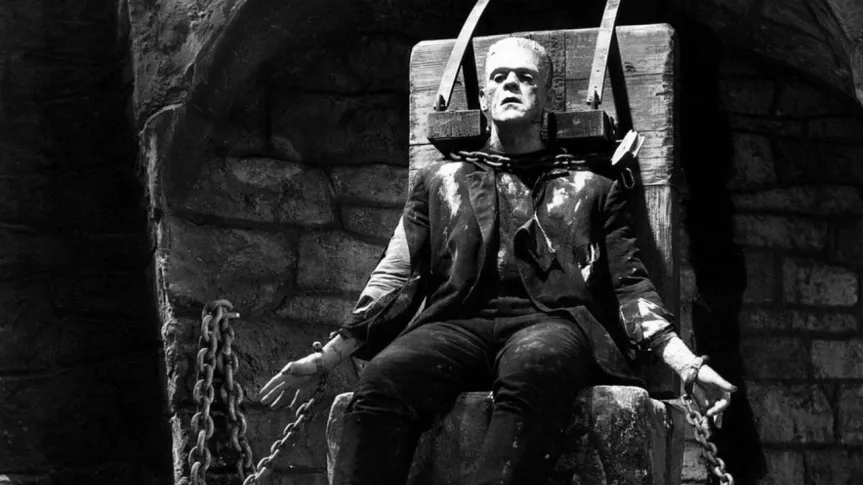a return of the “president”
There are few objects in the lexicon of luxury that can communicate quiet authority quite like the Rolex Day-Date. Since its debut in 1956, the model—known colloquially as the “President”—has symbolized prestige, diplomacy, and timeless refinement. It has graced the wrists of leaders, visionaries, and icons ranging from Lyndon B. Johnson to Warren Buffett.
In 2025, Classic 55 has breathed new life into this legacy, offering a revivalist take on the vintage Day-Date through their latest drop at Dover Street Market New York. Displayed in the store’s Jewelry Space, the collection captures the essence of old-world Rolex charm while introducing subtle restoration techniques and craftsmanship rarely seen in today’s hyper-commercial luxury watch landscape.
This isn’t about flipping hype or aftermarket maximalism. It’s about the reverence of history—each timepiece a conversation between eras, retaining the DNA of Rolex’s most influential model while adapting to the sensibilities of contemporary design.
the watch that defined decades
To understand why Classic 55’s offering resonates, one must revisit what made the Day-Date so revolutionary. When Rolex introduced the model in the mid-1950s, it became the first wristwatch to display both the day of the week spelled in full and the date window at 3 o’clock, powered by an automatic movement.
But beyond the mechanics, its social aura made it legendary. The watch’s nickname, “The President,” wasn’t conjured by marketing teams—it was earned. In 1965, photographs of U.S. President Lyndon B. Johnson wearing his yellow gold Day-Date made headlines, and the association stuck. Soon, the model adorned the wrists of diplomats, movie stars, and CEOs, standing for both achievement and composure.
With its fluted bezel, signature Cyclops lens, and President bracelet, the Day-Date became an aesthetic archetype. Yet, its design language evolved over the decades—from the classic ref. 1803 of the 1960s to the ref. 18038 and 18039 of the late 1970s and 1980s, introducing sapphire crystals, quickset date mechanisms, and Calibre 3055 movement.
These references—particularly the ref. 18039 in white gold—are what Classic 55 now resurrects, with the care and attention of a restoration atelier rather than a resale platform.
classic 55
Classic 55 operates at the intersection of heritage and customization. Founded on the principle that vintage watches deserve reinterpretation rather than replication, the brand sources, restores, and refines rare Rolex and Omega pieces—each with a story to tell.
What sets Classic 55 apart is its aesthetic restraint. Unlike the flashier world of custom diamond bezels or rainbow dials, their work celebrates subtlety. The bracelets are often hand-textured, cases softly refinished to preserve factory lines, and dials revived with period-correct luster rather than over-polished gleam.
The Day-Date seen in the Dover Street Market showcase encapsulates this ethos. The champagne dial glows with a golden patina, accented by factory diamond hour markers (with baguette indices at six and nine o’clock, a signature trait of Rolex’s original gem-set models). The case and bracelet, finished in what appears to be 18k white gold, show restrained signs of aging—evidence of careful restoration that respects the integrity of the metal rather than erasing its past.
Every detail speaks to preservation over perfection. The brushing on the President bracelet appears intentionally coarse, adding tactility and dimension under light. The fluted bezel, slightly softened by time, now catches the sun in a gentler shimmer than a freshly minted Rolex ever could.
dover
That Classic 55 chose Dover Street Market New York as its venue is no coincidence. DSM has long blurred the boundaries between luxury and subculture, hosting the likes of Comme des Garçons, NikeLab, and The Row under one eclectic roof.
By introducing a curated watch collection into this avant-garde ecosystem, Dover Street Market transforms the Day-Date from a symbol of executive tradition into an artifact of cultural reinvention. Here, vintage Rolexes don’t merely tell time—they tell stories.
Inside DSM’s Jewelry Space, the Classic 55 display juxtaposes gleaming vitrines with textural warmth. Photographs of vintage models accompany each watch, emphasizing the continuity of craft. It’s less a boutique display and more a micro-gallery on horological evolution.
The watches’ subdued tones—champagne, cream, soft gold—play against DSM’s industrial minimalism, highlighting how timeless design adapts to modern contexts without losing its dignity.
the modern collector’s eye
In today’s luxury landscape, the collector’s mindset has shifted. The chase for rarity has evolved from limited editions and hype releases to provenance, condition, and the artistry of restoration.
Classic 55 aligns with this ethos perfectly. Their clientele isn’t chasing status—they’re curating continuity. A vintage Rolex Day-Date, once a symbol of mid-century achievement, becomes in this context a wearable relic of design history.
There’s a generational handoff occurring here. For younger collectors who may have grown up during the quartz revolution or digital age, mechanical watches represent a return to analog beauty. A Rolex from the 1980s—ref. 18039, for instance—offers the tactility of old-world engineering: the slow sweep of the seconds hand, the satisfying “click” of the date change at midnight, the warmth of aged gold under sunlight.
These tactile experiences, preserved and reintroduced by Classic 55, resonate with modern sensibilities that prize longevity and texture over novelty.
the craft of preservation
Behind each Classic 55 Day-Date lies a process that borders on artistry. Restoration involves full disassembly of the Calibre 3055, ultrasonic cleaning, and careful oiling of micro-components. The watchmaker must balance authenticity with reliability—retaining original parts where possible, replacing only those necessary to ensure accuracy.
Dial refinishing is performed minimally or not at all; patina is embraced, not erased. Likewise, polishing is limited to maintain the integrity of edges and lugs—vital to retaining value among serious collectors.
This philosophy distinguishes Classic 55 from mass “vintage restockers.” Every watch remains fundamentally itself—refreshed, not reborn. The result is a piece that feels alive, breathing with history, yet capable of decades more wear.
the rolex day-date’s enduring symbolism
What makes the Day-Date so enduring is its duality. It’s both personal and political, both accessory and statement. It tells not only time, but context—where one has been and what one values.
Unlike sportier icons like the Submariner or GMT-Master, the Day-Date isn’t about adventure or utility. It’s about presence. It sits beneath a cuff during a meeting or glints subtly under a dinner jacket. It’s for those who measure time not by seconds, but by milestones.
Classic 55’s interpretation respects that identity. By avoiding over-customization, they allow the Day-Date’s original voice to come through: confident, restrained, dignified.
the dover street market flow
In the curated universe of DSM, a Rolex isn’t simply luxury—it’s narrative. Classic 55’s installation parallels how the store approaches fashion itself: through juxtaposition. Just as Rei Kawakubo revolutionized the concept of the garment, Classic 55 reimagines the watch as a living document.
To walk through DSM and encounter a Day-Date among conceptual jewelry and experimental design is to understand horology not as status, but as culture. The watch becomes a quiet echo of the store’s ethos: craft, rebellion, and legacy intertwined.
culture
This recontextualization mirrors broader movements across fashion and design. Vintage customization has risen as a counterpoint to fast luxury—think RRL’s denim revival, Bode’s upcycled tailoring, or Needles’ reworked tracksuits.
Classic 55 exists within that same creative frequency, extending the idea of bespoke repair into horology. The brand’s partnership with Dover Street Market legitimizes this approach at a cultural level, signaling a shift from product consumption to preservation as aesthetic expression.
A Classic 55 Rolex doesn’t feel “new.” It feels considered. Each watch whispers of boardrooms, dinner tables, and decades of ticking away in quiet defiance of obsolescence.
crawl
The future of vintage luxury lies not in nostalgia, but in translation. As more consumers turn toward sustainable, collectible goods, the restored timepiece becomes a conduit between eras.
Classic 55’s success at Dover Street Market suggests that horological restoration is entering the fashion mainstream—no longer the domain of dusty collectors, but a form of wearable storytelling aligned with the cultural rhythms of art, design, and music.
One can imagine further collaborations—perhaps with artisans or even with Rolex itself, should Geneva ever choose to embrace its own aftermarket narratives. But for now, Classic 55’s approach feels refreshingly independent, quietly radical in a world obsessed with newness.
the allure of time, renewed
At its core, what Classic 55 offers is not just a watch—it’s a reassertion of value. It’s a reminder that craftsmanship endures, that beauty need not be flawless, and that the stories embedded in metal and glass can transcend decades.
The Rolex Day-Date, in Classic 55’s hands, is no longer merely a marker of power. It’s an artifact of continuity—proof that refinement can evolve without erasing its roots.
Standing beneath the sharp lights of Dover Street Market, its champagne dial glimmering softly, the watch tells time in more ways than one. It speaks of craftsmanship revived, of elegance redefined, and of how even in a world of fleeting trends, the truly classic never really leaves—it simply returns, renewed.
No comments yet.








